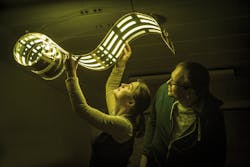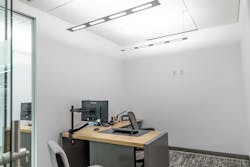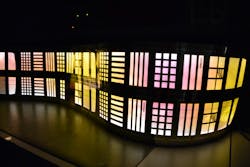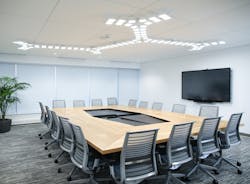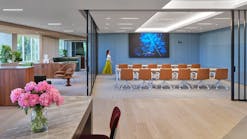OLEDs still face a cost challenge in general lighting (MAGAZINE)
Remember the brave new OLED technology future, in which organic light-emitting diodes were going to make the LED revolution a short-lived one? Certainly, you recall how proponents have declared that OLEDs — thin sheets of either rigid or bendable material that light up — would replace single-point LEDs as the big thing in general illumination, offering untold advantages in design and light quality.
In case you haven’t noticed, the revolution hasn’t happened. Some 32 years after Eastman Kodak invented OLEDs, and a dozen or more years after lighting companies first started talking up the possibilities in the general illumination market, OLEDs have yet to make many inroads there. While they have their place in the altogether different market for display screens, and might be gaining a presence in the automotive industry for tail lights, in general illumination they have been mostly relegated to high-end architectural deployments where even there they are competing with improved LED designs. Those designs include edge-lit planar fixtures that use optical light guides to deliver more uniform and diffuse LED illumination, as LEDs Magazine covered back in 2016.
Along the way there have been casualties. Most recently, LG, one of the few makers of OLED panels for general lighting, seems to have withdrawn from the market. Although it still makes OLEDs for display screens, word on the street is that earlier this year it decided it had enough of OLEDs for illumination, pulling the plug on assembly of both panels and finished luminaires. (Despite our best efforts, LEDs Magazine has not been able to get LG to confirm.)
And the two biggest names in lighting, Signify and Osram, both decided against OLEDs in recent years with Signify (then Philips Lighting) selling off its OLED operation in 2015, and Osram CEO Olaf Berlien declaring OLEDs as too costly for the lighting market in 2016. In fact, Osram is winding down all OLED operations — it will still provide product to the auto industry for tail lights — by the end of this year.
And it is costs that remain the number one challenge for the industry, which seems to have now leapt over two other hurdles that have been holding it back: energy efficiency and product longevity.
But wait a moment. OLEDs never were supposed to take over for LEDs in the first place. The two technologies have always been on a path to coexist. At least that’s what OLED supporters are saying now. It’s a matter of opinion as to whether they are rewriting the perspective on OLED’s history, or whether they themselves have been victimized by the high expectations imposed by marketing and media hype and are now setting the record straight.
The reality, however, does indeed seem to be that OLEDs are now poised to at least coexist with LEDs, and could do so within the next few years — if only more lighting companies would embrace the technology and thus drive down those costs that Osram cited as so troublesome.
“There certainly was a tremendous amount of excitement when the technology first made an entreé into lighting, and the lighting industry started looking at it,” said Jeannine Wang, director of design partnership for Acuity Brands, one of the few major lighting companies that is actively developing and selling OLED luminaires. “There were some folks that sort of put out the idea that OLEDs would replace LED. I’m not really sure where that idea came from. Because from a fundamental understanding of how the technologies work in lighting, just the physics of it, the two technologies work in a very complementary way.”
Soft touch
Because OLEDs by their nature emit a softer, diffuse, and glare-free light that is easier on the eye than LEDs, they can be a better human-centric choice. On the other hand, LEDs, with their single light point, are better at squeezing into a small package and throwing light a long distance. OLEDs can produce white light without using anywhere near the amount of blue that LEDs require, making them ideal for locations or applications that want to minimize exposure to blue-rich light, such as in spaces where workers are on a night-time shift schedule. They also can be built to eliminate infrared (IR) or ultraviolet (UV) wavelengths. So they could have use in specific applications such as lighting artwork, illuminating food in supermarkets, showing off perfume in display cases, or anything else subject to perish when exposed to UV or IR.
But to repeat the newly-established prevailing wisdom, the two lighting technologies will coexist. In one microcosm example, Acuity builds both into its latest Olessence OLED luminaire, introduced in May. The hanging ceiling luminaire delivers diffuse and glare-free direct white lighting downward with OLEDs while pointing LEDs up to the ceiling for indirect lighting.
Christian May, division director of flexible organic electronics at Fraunhofer FEP in Dresden, Germany, and an OLED advocate who is working on a production process that could help cut manufacturing costs, agreed that OLEDs were never meant to replace LEDs.
“It would be nice to have more OLED in general illumination,” said May. “But is there really a need? Yes, there is, but a lot of the daily needs can be served by other technologies, especially LEDs, in a good manner — not necessarily in the best manner, but in a good manner, and for a very reasonable price. Therefore, for the very broad applications, there is not a need for OLED. Of course, we have advantages like very good quality of lighting, like color rendering index, and so on. And more and more studies are coming showing this is really important for human wellbeing. But to be honest, for daily life and all the daily investment on a small scale in households, and large scale in industry, it’s more important you can make a good approach with existing inorganic LED technology.”
Cost concerns
That might sound like odd talk coming from an OLED enthusiast. But inherent in May’s observations is this: If OLEDs are to nudge their way more into LED territory, production prices will have to come down. And that is precisely what May is working on at Fraunhofer, developing a roll-to-roll (R2R) production process that, if successful, would replace the more expensive sheet-to-sheet process used today.
That’s a good thing in the eyes of many, because, despite all the “coexistence” talk, there is a sense that OLEDs have indeed underachieved in the market.
“There is a need and an opportunity for someone to come up with a diffuse surface source of solid-state lighting [SSL] that helps produce products that are glare free and that have a thin and conformable (bendable into a set shape) form factor,” said independent consultant Norman Bardsley, who is based in Danville, CA and who advises the US Department of Energy on SSL. “That has not happened in the way that I hoped and the way a lot of people hoped... I don’t think that OLEDs have yet lost out to LEDs in this regard, but there has certainly been a struggle to get their efficiency up and their cost down. And it’s the cost that’s the big thing.”
Rolling on
Bardsley is impressed by the R2R work at Fraunhofer, which could succeed where others have not. Konica Minolta invested heavily in an R2R line earlier this decade but failed to fire it up commercially. Other entities are also working on it, like Taiwan’s Industrial Technology Research Institute (ITRI), a government-backed group.
At Fraunhofer, May said that OLED R2R is for the most part ready and it simply awaits market demand. “The general message is OLED processing and roll-to-roll is possible. We have done it the last year up to a certain level and we are going ahead in this direction. In general, the technology is more or less ready.”
There is, however, a chicken-and-egg conundrum: There is no mass market of takers.
“Roll-to-roll technology is attractive if you have a large market which can’t be served by the conventional sheet-to-sheet processing in an adequate manner,” said May. “But first you have to have a market. For that, you have to have volume that we don’t have at this time. It’s very important to prepare the market for penetration in order activate roll to roll.”
Or, as Bardsley put it, “Their problem is they haven’t found a way to couple it to the industry.”
The half-full glass
The notion that the pieces are in place for OLED prominence, and that all it will take now is market acceptance, resonates as a classic “glass half-empty, half-full” situation. (Please excuse our mixed chickens and glass idioms!) On the half-full side, observers are wondering why, after all these years, end users and luminaire makers haven’t yet clamored for OLED materials from producers. Among the reasons they note is that advances in LED technology such as edge emitters and other developments have allowed LED designers to mimic some of the planar lighting capability of OLEDs, as mentioned earlier.
On the half-full side, enthusiasts like Acuity’s Wang insist that acceptance is just around the corner.
No group is more optimistic than Acuity’s exclusive OLED panel provider, OLEDWorks, the company founded in 2010 by scientists who had worked for OLED inventor Kodak. Based in Kodak’s hometown of Rochester, NY, OLEDWorks is carrying the OLED torch.
CEO and co-founder David DeJoy noted that in the few instances in which OLEDs have been used to directly light large spaces, the reaction has been overwhelmingly positive. “People’s consistent experience is this just feels good. It feels like a nice space to be in,” said DeJoy, who has helped outfit offices in the Rochester area with OLED lighting. Among the technology’s many attributes that he singles out is its “Lambertian” quality — its ability to spread light around equally.
“If you look at the fundamentals of the technology, as a Lambertian area light source that’s broad spectrum and naturally diffuse, it’s really a very good complement to LED,” DeJoy says.
It sounds like DeJoy counts himself in the OLED/LED coexistence camp.
“These are not technologies that should be fighting each other,” he says, pointing to the Acuity hybrid Olessence luminaire as an example. “They are technologies that if used properly are harmonious.”
But that harmony will not come until the costs come down. Again, DeJoy is optimistic, noting that OLEDWorks has honed its sheet-to-sheet facilities to the point where all the company needs is volume to operate economically for a broad commercial market.
“Our business model, like LED’s business model, really benefits from scale,” says DeJoy. “Our current manufacturing facilities, including the facility we acquired from Philips in 2015 in Aachen, Germany, and our Rochester facility, which we innovated and developed ourselves, both really benefit from scale. Our supply chain knows that. Our costs can really decelerate as volume increases.”
Although in the long run OLEDWorks hopes to move to R2R — it is watching developments at Fraunhofer closely — it is ready to go with sheet to sheet.
Looking for partners
And to help instigate the volumes that would make its line financially viable, OLEDWorks last July launched a channel partner program that would encourage more luminaire makers to commit to OLEDs. Although as of this writing it had not announced any actual partners (longtime partner Acuity would not be in the new program), DeJoy was confident it would have names soon.
It also helps that OLEDWorks is getting far more active in the auto industry, making OLEDs for tail lights using the same production line that it uses for general lighting products. Its automobile partners include Audi, and it is believed to be picking up work that Osram is giving up.
DeJoy was also quick to point out, as are many OLED developers, that end product costs for OLED luminaires benefit because they require far fewer system components such as optics, drivers, diffusers, heat sinks, and wave guides compared to LEDs.
“What we think about is really the system cost of the delivered luminaire, not just the light engine cost,” says DeJoy. Once OLEDWorks cranks up the volume on its existing line, it will produce at a cost that will make the cost of finished OLED luminaires comparable with LED luminaires, he says.
Another development that has helped to lower OLED system costs is that OLED panel makers such as OLEDWorks have now advanced the energy efficiency of their products to around 85 lm/W, which is comparable to many LEDs. However, as the DOE reported in findings from its latest report on stress-testing OLED products, longevity and chromaticity shift can still be improved.
Efficiency improvements have enabled luminaire makers like Acuity to do more with less. Acuity’s Wang noted that its original Olessence luminaire several years ago had two parallel lines of OLED panels, each delivering around 150 lm/ft of downlight; the new hybrid uses only one line of panels, each delivering 300 lm/ft. “We were able to reduce the footprint by roughly half,” said Wang. “We’re using half the OLED area to produce twice as much light.”
Raw OLED efficiencies do still vary, and developers are applying different techniques to improve them. OLEDWorks, for one, has been extracting more photons, working with Penn State University.
But OLEDs today generally compare equally to LEDs on a finished luminaire basis, once you factor in components such as lampshades or diffusers that essentially reduce the efficacy of an LED.
“Eighty-five lumens per watt is comparable to the decorative LEDs as they are usually below 100 lumens per watt,” notes consultant Bardsley. “The LED high bays where you don’t care much about form factor, and troffers that you can put in your ceiling but that look pretty ugly, are above 100 lumens per watt. Essentially, anything other than that, even the general-purpose LED bulbs, once you put a shade around them to stop the glare, are going to give you effectively less than a hundred lumens per watt.”
And despite the DOE’s concerns over OLED lifetimes, OLEDWorks’ DeJoy notes that longevity has greatly improved. OLEDWorks rates the lifetime of its panels at up to 100,000 hours for a rigid model shining at 3000 candelas/m2, although the same model at 8400 cd/m2 comes in at 30,000 hours, both in 3000K configuration. It rates other models at 25,000 hours, 30,000 hours, and 50,000 hours, varying with brightness, spectral content, and whether the OLED is rigid or curved (rigid lasts longer).
“Claims of lifetimes of over 100,000 hours are always problematic, since it takes a long time to do effective tests,” added Bardsley. “It is certainly true that the use of multiple stacks has substantially reduced the rate of lumen depreciation in OLEDs, since the current densities are low. Other reliability factors are probably more important, especially early failures. It is hard to get data on this, since it is dependent on the way the light is installed and used.”
But in the main, OLEDs are lasting longer, are efficient, and costs are ready to come down. All it will take is for people to buy them. This is either the last hurrah for OLEDs in the general lighting market or a new horizon.
MARK HALPER is a contributing editor for LEDs Magazine, and an energy, technology, and business journalist ([email protected]).

Mark Halper | Contributing Editor, LEDs Magazine, and Business/Energy/Technology Journalist
Mark Halper is a freelance business, technology, and science journalist who covers everything from media moguls to subatomic particles. Halper has written from locations around the world for TIME Magazine, Fortune, Forbes, the New York Times, the Financial Times, the Guardian, CBS, Wired, and many others. A US citizen living in Britain, he cut his journalism teeth cutting and pasting copy for an English-language daily newspaper in Mexico City. Halper has a BA in history from Cornell University.
